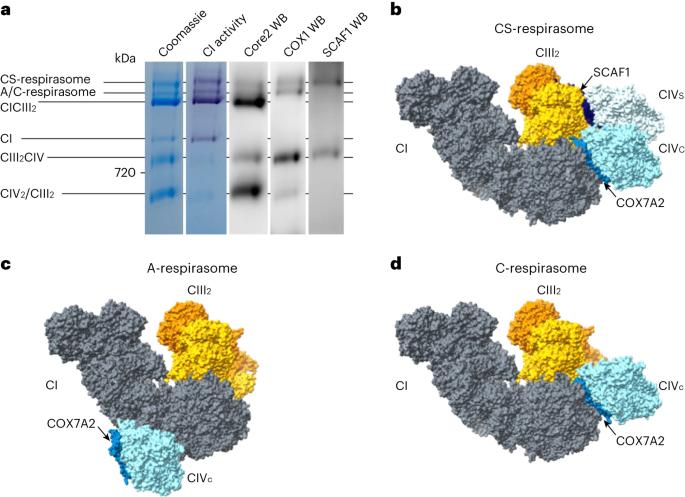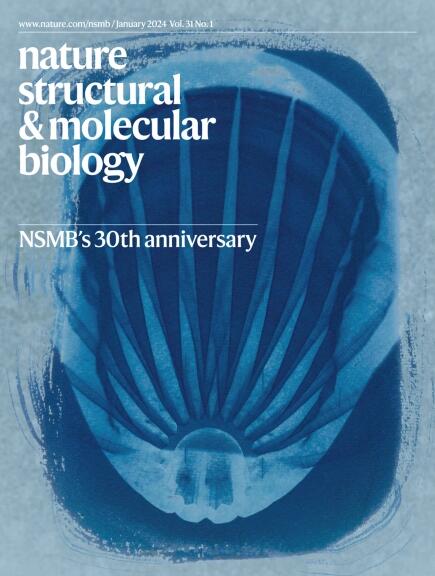SCAF1 drives the compositional diversity of mammalian respirasomes
IF 12.5
1区 生物学
Q1 BIOCHEMISTRY & MOLECULAR BIOLOGY
引用次数: 0
Abstract
Supercomplexes of the respiratory chain are established constituents of the oxidative phosphorylation system, but their role in mammalian metabolism has been hotly debated. Although recent studies have shown that different tissues/organs are equipped with specific sets of supercomplexes, depending on their metabolic needs, the notion that supercomplexes have a role in the regulation of metabolism has been challenged. However, irrespective of the mechanistic conclusions, the composition of various high molecular weight supercomplexes remains uncertain. Here, using cryogenic electron microscopy, we demonstrate that mammalian (mouse) tissues contain three defined types of ‘respirasome’, supercomplexes made of CI, CIII2 and CIV. The stoichiometry and position of CIV differs in the three respirasomes, of which only one contains the supercomplex-associated factor SCAF1, whose involvement in respirasome formation has long been contended. Our structures confirm that the ‘canonical’ respirasome (the C-respirasome, CICIII2CIV) does not contain SCAF1, which is instead associated to a different respirasome (the CS-respirasome), containing a second copy of CIV. We also identify an alternative respirasome (A-respirasome), with CIV bound to the ‘back’ of CI, instead of the ‘toe’. This structural characterization of mouse mitochondrial supercomplexes allows us to hypothesize a mechanistic basis for their specific role in different metabolic conditions. Here the authors structurally characterize respiratory supercomplexes, revealing that, in addition to the known ‘canonical’ respirasome, mammalian mitochondria contain two novel respirasome types, one of which incorporates supercomplex assembly factor SCAF1.

SCAF1 驱动哺乳动物呼吸体的组成多样性
呼吸链超级复合体是氧化磷酸化系统的既定组成成分,但它们在哺乳动物新陈代谢中的作用一直备受争议。尽管最近的研究表明,不同的组织/器官根据其新陈代谢的需要配备了特定的超级复合体,但超级复合体在新陈代谢调节中发挥作用的观点受到了质疑。然而,无论机理结论如何,各种高分子量超级复合物的组成仍然不确定。在这里,我们利用低温电子显微镜证明哺乳动物(小鼠)组织含有三种确定类型的 "呼吸体",即由 CI、CIII2 和 CIV 组成的超级复合物。三种呼吸体中 CIV 的配量和位置各不相同,其中只有一种含有超级复合物相关因子 SCAF1。我们的结构证实,"标准 "呼吸小体(C-呼吸小体,CICIII2CIV)不含 SCAF1,而与另一个呼吸小体(CS-呼吸小体)相关,含有第二个 CIV 拷贝。我们还发现了另一种呼吸体(A-呼吸体),CIV 与 CI 的 "背面 "而不是 "脚趾 "结合。通过对小鼠线粒体超级复合物结构的描述,我们可以假设它们在不同代谢条件下发挥特定作用的机理基础。
本文章由计算机程序翻译,如有差异,请以英文原文为准。
求助全文
约1分钟内获得全文
求助全文
来源期刊

Nature Structural & Molecular Biology
BIOCHEMISTRY & MOLECULAR BIOLOGY-BIOPHYSICS
CiteScore
22.00
自引率
1.80%
发文量
160
审稿时长
3-8 weeks
期刊介绍:
Nature Structural & Molecular Biology is a comprehensive platform that combines structural and molecular research. Our journal focuses on exploring the functional and mechanistic aspects of biological processes, emphasizing how molecular components collaborate to achieve a particular function. While structural data can shed light on these insights, our publication does not require them as a prerequisite.
 求助内容:
求助内容: 应助结果提醒方式:
应助结果提醒方式:


